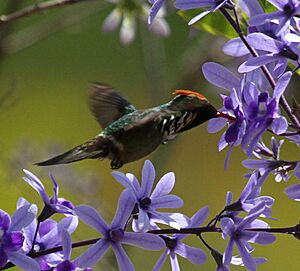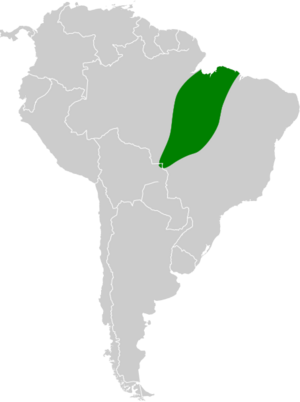Dot-eared coquette facts for kids
Quick facts for kids Dot-eared coquette |
|
|---|---|
 |
|
| Lophornis gouldii in Brasília, Brazil | |
| Conservation status | |
| Scientific classification | |
| Genus: |
Lophornis
|
| Species: |
gouldii
|
 |
|
The dot-eared coquette (Lophornis gouldii) is a tiny, colorful hummingbird that lives in parts of Bolivia and Brazil. It's known for its bright feathers and unique "dot-eared" look, especially the males. This little bird is part of a group of hummingbirds called "coquettes."
Contents
About the Dot-Eared Coquette
The dot-eared coquette is a special type of hummingbird. It is the only species in its group, which means it doesn't have any close relatives that are also called "dot-eared coquettes."
What Does It Look Like?
The dot-eared coquette is a very small bird. It is about 6.8 to 7.6 centimeters (2.7 to 3 inches) long. It weighs only about 2.4 to 2.8 grams (0.08 to 0.1 ounces). Both male and female birds have a short, straight bill that is red with a black tip.
Male Coquette
The adult male has a shiny golden-green forehead. It also has long, dark reddish-brown feathers on its head that form a crest. Its upper body is a bronze-green color with a white band across its lower back.
The male's throat is a sparkling emerald green. It has long white feathers on its cheeks with bright green dots. These feathers fan out, giving it a unique "dot-eared" look. Its belly is grayish-green. The middle tail feathers are bronze-green, while the others are reddish-brown with bronze-green tips.
Female Coquette
The adult female looks a bit different from the male. She does not have the crest on her head or the special cheek feathers. Her upper body is similar to the male's, but it has a bronze shimmer.
The female's throat is reddish-brown with a grayish-green edge below it. Her tail is bronze with reddish-brown tips. Young birds look similar to the adult female.
Where Do They Live?
Dot-eared coquettes mostly live in Brazil. You can find them from the mouth of the Amazon River all the way south and west to areas like Mato Grosso and Goiás. Sometimes, they are seen as far away as the Santa Cruz area in Bolivia.
These birds prefer places that are partly open, like the edges of forests. They also live in savannas and a type of grassland called cerrado. They can be found from sea level up to about 800 meters (2,600 feet) high.
How Do They Behave?
Staying in One Place
Scientists believe that dot-eared coquettes usually stay in the same area. They do not travel long distances or migrate. This means they are "sedentary."
What Do They Eat?
Dot-eared coquettes are "trap-line" feeders. This means they visit a regular path of flowering plants to drink nectar. They fly from one flower to another, like following a route. We don't know all the details of what else they eat.
Raising Their Young
The breeding season for dot-eared coquettes is from December to April. We don't have many details about their nests. The female bird lays two eggs and sits on them for about 14 days to keep them warm. The baby birds leave the nest about 22 days after they hatch.
Sounds They Make
Dot-eared coquettes are usually quiet birds. When they are feeding, they might make a short "tsip" sound. When they hover in the air, their wings make a soft, bee-like humming noise.
Their Conservation Status
The IUCN (International Union for Conservation of Nature) keeps track of how many animals are left in the wild. In 2000, they thought the dot-eared coquette was not in danger. But in 2012, its status changed to "Vulnerable," meaning it was more at risk.
In 2021, its status changed again to "Near Threatened." This means it could become endangered soon if things don't improve. There are an estimated 28,000 to 376,000 adult dot-eared coquettes left. However, their numbers are expected to drop by as much as 29% by 2031. This is mainly because of forests being cut down and new dams being built for electricity.


